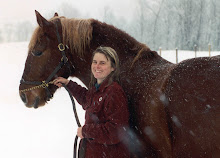Tonight, I’ll cover what I can, but frankly, I think we’re doomed for a major setback. All day, since 4 am, the wind has been howling, and the temperature dropping. I even kept the sheep inside today, despite the sun. They are freshly shorn (meaning their wool has been removed), and I wouldn’t appreciate being out in this without a winter coat if I were them.
The plants have definitely been confused by this climate change, but surprisingly, the birds are still right on schedule. I’ve kept a log of what arrives back on the farm since 1997, and they are within a week of normal.
On the other hand, Kyle harvested horseradish yesterday (we usually do this in the fall, but there were some escapees from the raised bed). I also harvested wild leeks that are usually blanketed under many feet of snow at this time. The mosquitoes were out in full force as I put an electric fence around the wrapped hay bales (the sheep are blowing through the single strand fence to get at the lush, green grass), and the ticks are crazy bad.
Did you know that horseradish is actually a Brassica, meaning it’s related to broccoli, cabbage and mustard? It’s been used since the middle ages, mostly medicinally back then, and its origin is most likely south eastern Europe or western Asia.
We tend not to use it much as Americans, unless it’s on our roast beef, in our shrimp cocktail sauce or as an essential ingredient to a bloody Mary. The stuff we Americans think of as Wasabi is usually not the root of the Wasabi plant (which although is related to horseradish is generally not found outside of Japan due to the difficulty in propagating it). Instead, what we call Wasabi is a mixture of horseradish, mustard and green food coloring. Still good though.
Horseradish is a perennial and pretty easy to grow. The best way to harvest it is in the fall, when you divide the roots; older roots will get woody and tough, whereas new growth is slender and spirited. I like to prepare it with vinegar, salt and a little mustard oil (you can get this at ethnic markets). It’ll keep in the fridge for months, but when it starts turning brown, it’s lost its zing. Propagating it is pretty simple too; just pull the whole root out and lop off the top inch or two with the new growth. Stick it in the soil medium, and water it until it develops new roots. Then transplant it into your bed outside.
I’m eating horseradish now, as the wind whips by the farm, bringing with it the sting of a March going out like a lion. We all knew it was abnormal to have sunburns at this time when we’re usually slogging through mud and snow. Hopefully the rest of spring will even out in temperament.
Braised Pork with Vinegar, Horseradish and Mashed Potatoes
Pork:
2 tbsp oil
2-3 pounds of pork shoulder, fresh ham, or chops
Salt and pepper
2 cups onions, sliced or small, whole
½ cup red wine vinegar
½ cup dry red wine
Parsley for garnish
2 tbsp prepared horseradish
In a Dutch oven or covered cast iron casserole dish, heat the oil. Add the meat and brown on both sides, turning every so often (about 2-3 minutes). Season with salt and pepper as you do this. Use medium heat so the fat doesn’t burn.
Take the meat out, then add the onions, vinegar and wine. Cook until the onions are translucent. Shred the meat and return it to the sauce. Serve over mashed potatoes. Garnish with parsley and prepared horseradish.
Mashed Potatoes:
Russet Potatoes, quartered, scrubbed, but not peeled
Cream
Salt and Pepper
Put the quartered potatoes in a pan and fill 1/3 with cream. Cook gently, covered, until the potatoes are soft. Mash lightly (don’t mix them too much, or they’ll turn to mush) and season to taste with salt and pepper. Keep warm.

No comments:
Post a Comment